A Poisson Process-Based Random Access Channel for 5G and Beyond Networks †
Abstract
1. Introduction
Contributions of the Paper
- This paper assesses the strengths of Poisson distribution RVs as compared to the uniform distribution RVs.
- We propose a 2PRACH mechanism, which suggests replacing UD with ED in random access mechanism for 5G/B5G networks.
2. Related Research Works
Problem Statement
3. Existing Contention-Based Random-Access Mechanism
3.1. Preamble Transmission (UE → eNB)
3.2. Random Access Response (RAR) (eNB → UE)
3.3. RRC Connection Request (UE → eNB)
3.4. RRC Connection Setup (eNB → UE)
4. Proposed Poisson Process-Based RACH (2PRACH) Mechanism
5. Performance Evaluation
5.1. Discussion on the Substantial Impact
5.2. Limitations of the Work
6. Conclusions and Future Work
Author Contributions
Funding
Institutional Review Board Statement
Informed Consent Statement
Data Availability Statement
Acknowledgments
Conflicts of Interest
Abbreviations
| 3GPP | Third Generation Partnership Project |
| CB | Contention-based |
| CED | Continuous Exponential Distribution |
| CF | Contention-free |
| CRP | Contention Resolution Period |
| DL | Down-link |
| DUD | Discrete Uniform Distribution |
| eNB | Evolved Node B |
| EPC | Evolved Packet Core |
| LTE-A | Long Term Evolution-Advanced |
| MIB | Master Information Block |
| Probability Density Function | |
| PDP | Power Delay Profile |
| PRACH | Physical Random Access Channel |
| PSS | Primary Synchronization Signal |
| RA | Random Access |
| RAN | Radio Access Network |
| RAR | RA response |
| RL | Reinforcement Learning |
| RNTI | Radio Network Temporary Identity |
| RRC | Radio Resource Connection |
| SIB | System Information Block |
| SSS | Secondary Synchronization Signal |
| TA | Timing Advance |
| UE | User Equipment |
| UL | Up-link |
References
- Rangan, S.; Rappaport, T.S.; Erkip, E. Millimeter-wave cellular wireless networks: Potentials and challenges. Proc. IEEE 2014, 102, 366–385. [Google Scholar] [CrossRef]
- Rappaport, T.S.; Gutierrez, F.; Ben-Dor, E.; Murdock, J.N.; Qiao, Y.; Tamir, J.I. Broadband millimeter-wave propagation measurements and models using adaptive-beam antennas for outdoor Urban cellular communications. IEEE Trans. Antennas Propag. 2013, 61, 1850–1859. [Google Scholar] [CrossRef]
- Hong, W.; Baek, K.-H.; Lee, Y.; Kim, Y.; Ko, S.-T. Study and prototyping of practically large-scale mmWave antenna systems for 5G cellular devices. IEEE Commun. Mag. 2014, 52, 63–69. [Google Scholar] [CrossRef]
- 3GPP. Study on Scenarios and Requirements for Next-Generation Access Technologies (Release 14); V14.2.0; Rep. TR 38.913; 3GPP: Sophia Antipolis, France, 2017. [Google Scholar]
- Bajracharya, R.; Shrestha, R.; Ali, R.; Musaddiq, A.; Kim, S.W. LWA in 5G: State-of-the-art architecture, opportunities, and research challenges. IEEE Commun. Mag. 2018, 56, 134–141. [Google Scholar] [CrossRef]
- Misic, V.B.; Misic, J. Machine-to-Machine Communications: Architectures, Technology, Standards, and Applications; CRC Press: Boca Raton, FL, USA, 2014. [Google Scholar]
- 3GPP. TS 36.300 V11.2.0—Evolved Universal Terrestrial Radio Access (E-UTRA) and Evolved Universal Terrestrial Radio Access Network (EUTRAN); Overall Description; 3GPP: Sophia Antipolis, France, 2012. [Google Scholar]
- 3GPP. TS 38.300, NR; Overall Description; Stage-2; Release 15, v15.1.0; 3GPP: Sophia Antipolis, France, 2018. [Google Scholar]
- Hoglund, A.; Van, D.P.; Tirronen, T.; Liberg, O.; Sui, Y.; Yavuz, E.A. 3GPP Release 15 Early Data Transmission. IEEE Commun. Stand. Mag. 2018, 2, 90–96. [Google Scholar] [CrossRef]
- Condoluci, M.; Dohler, M.; Araniti, G.; Molinaro, A.; Sachs, J. Enhanced Radio Access and Data Transmission Procedures Facilitating Industry Compliant Machine Type Communications over LTE-based 5G Networks. IEEE Wirel. Commun. 2016, 23, 56–63. [Google Scholar] [CrossRef]
- Chen, Y.-J.; Cheng, L.-Y.; Wang, L.-C. Prioritized Resource Reservation for Reducing RA Delay in 5G URLLC. In Proceedings of the 2017 IEEE 28th Annual International Symposium on Personal, Indoor, and Mobile Radio Communications (PIMRC), Montreal, QC, Canada, 8–13 October 2017; pp. 1–5. [Google Scholar]
- Jiang, N.; Deng, Y.; Condoluci, M.; Guo, W.; Nallanathan, A.; Dohler, M. RACH Preamble Repetition in NB-IoT Network. IEEE Commun. Lett. 2018, 22, 1244–1247. [Google Scholar] [CrossRef]
- Vural, S.; Wang, N.; Foster, G.; Tafazolli, R. Success Probability of Multiple-Preamble Based Single-Attempt Random Access to Mobile Networks. IEEE Commun. Lett. 2017, 21, 1755–1758. [Google Scholar] [CrossRef]
- Thota, J.; Aijaz, A. On Performance Evaluation of Random-Access Enhancements for 5G uRLLC. In Proceedings of the 2019 IEEE Wireless Communications and Networking Conference (WCNC), Marrakesh, Morocco, 15–18 April 2019; pp. 1–7. [Google Scholar] [CrossRef]
- Arouk, O.; Ksentini, A. General Model for RACH Procedure Performance Analysis. IEEE Commun. Lett. 2016, 20, 372–375. [Google Scholar] [CrossRef]
- Choi, J.; Shin, D. Generalized RACH-Less Handover for Seamless Mobility in 5G and Beyond Mobile Networks. IEEE Wirel. Commun. Lett. 2019, 8, 1264–1267. [Google Scholar] [CrossRef]
- Choi, J. On the Adaptive Determination of the Number of Preambles in RACH for MTC. IEEE Commun. Lett. 2016, 20, 1385–1388. [Google Scholar] [CrossRef]
- Ali, M.S.; Hossain, E.; Kim, D.I. LTE/LTE-A Random Access for Massive Machine-Type Communications in Smart Cities. IEEE Commun. Mag. 2017, 55, 76–83. [Google Scholar] [CrossRef]
- Hsu, C.; Das, K.; Jorguseski, L. Multi-RAT Random Access Scheme Utilising Combined Licensed and Unlicensed Spectrum for Massive Machine-Type Communications. In Proceedings of the 2020 IEEE 91st Vehicular Technology Conference (VTC2020-Spring), Antwerp, Belgium, 25–28 May 2020; pp. 1–7. [Google Scholar] [CrossRef]
- Liu, Y.; Deng, Y.; Jiang, N.; Elkashlan, M.; Nallanathan, A. Analysis of Random Access in NB-IoT Networks with Three Coverage Enhancement Groups: A Stochastic Geometry Approach. IEEE Trans. Wirel. Commun. 2021, 20, 549–564. [Google Scholar] [CrossRef]
- Althumali, H.D.; Othman, M.; Noordin, N.K.; Hanapi, Z.M. Dynamic Backoff Collision Resolution for Massive M2M Random Access in Cellular IoT Networks. IEEE Access 2020, 8, 201345–201359. [Google Scholar] [CrossRef]
- Lee, B.-H.; Lee, H.-S.; Moon, S.; Lee, J.-W. Enhanced Random Access for Massive Machine Type Communications. IEEE Internet Things J. 2020. [Google Scholar] [CrossRef]
- NS-3, A Discrete-Event Network Simulator Release 3.30.1. Available online: https://www.nsnam.org/doxygen/group_lte.html (accessed on 1 January 2020).
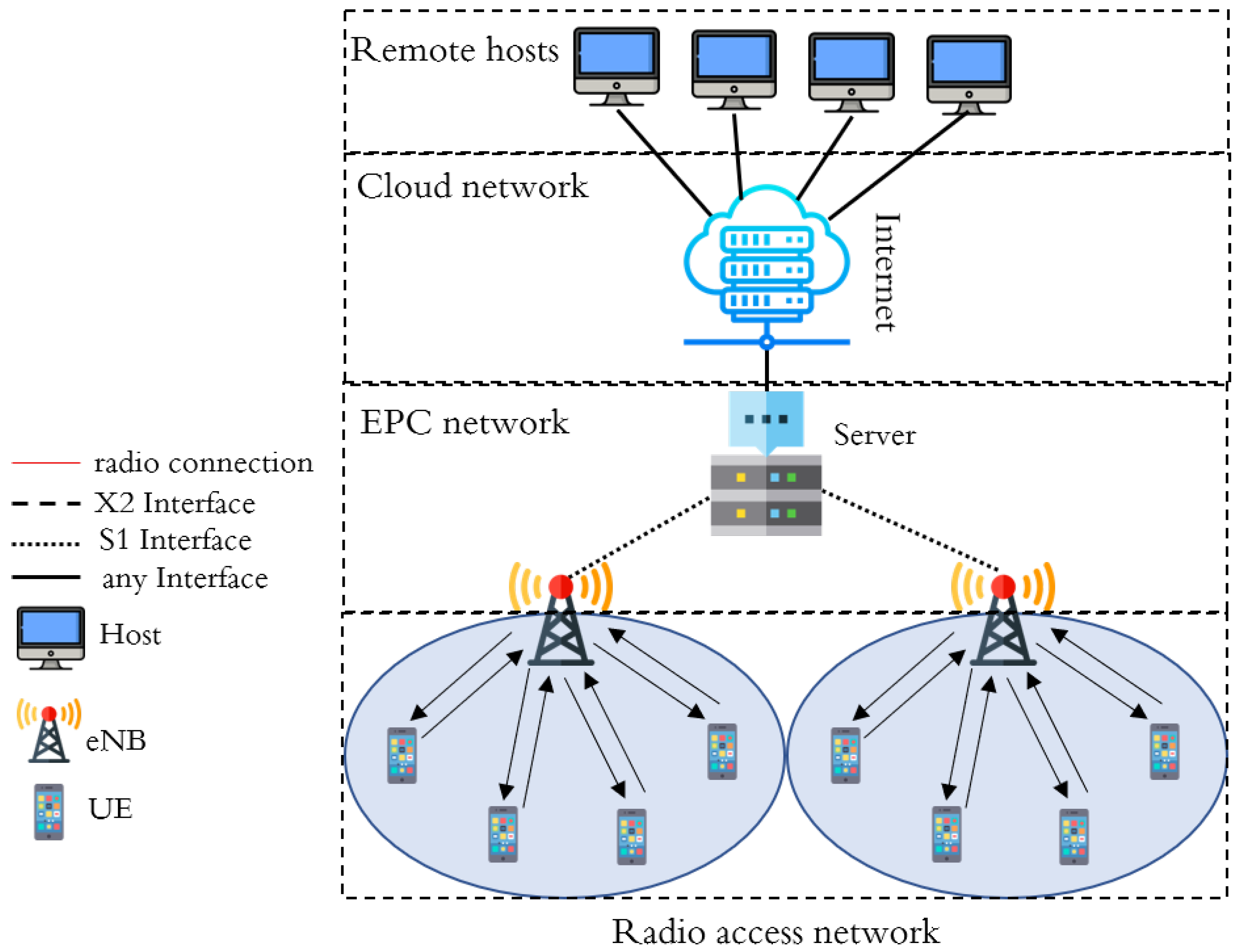
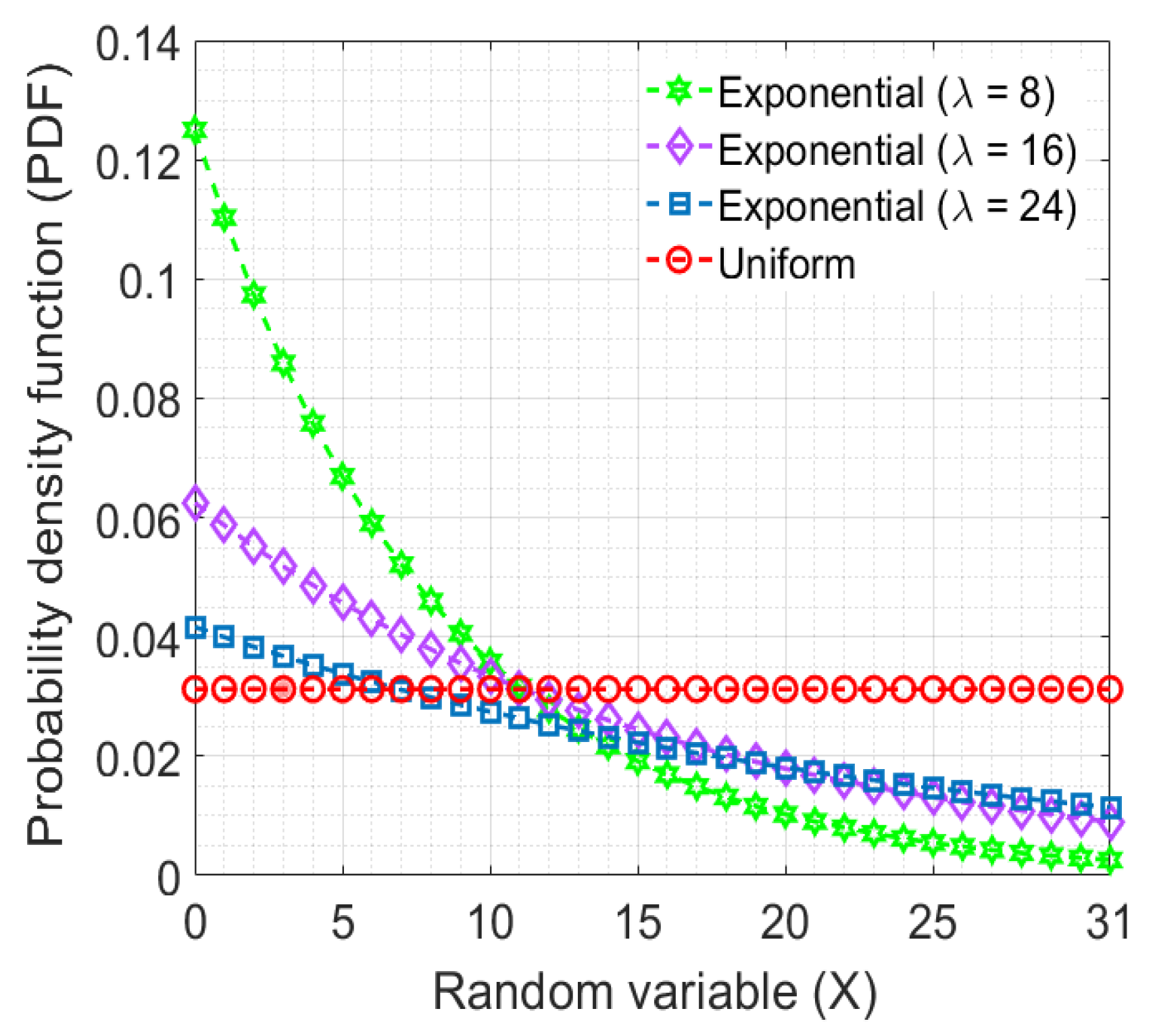
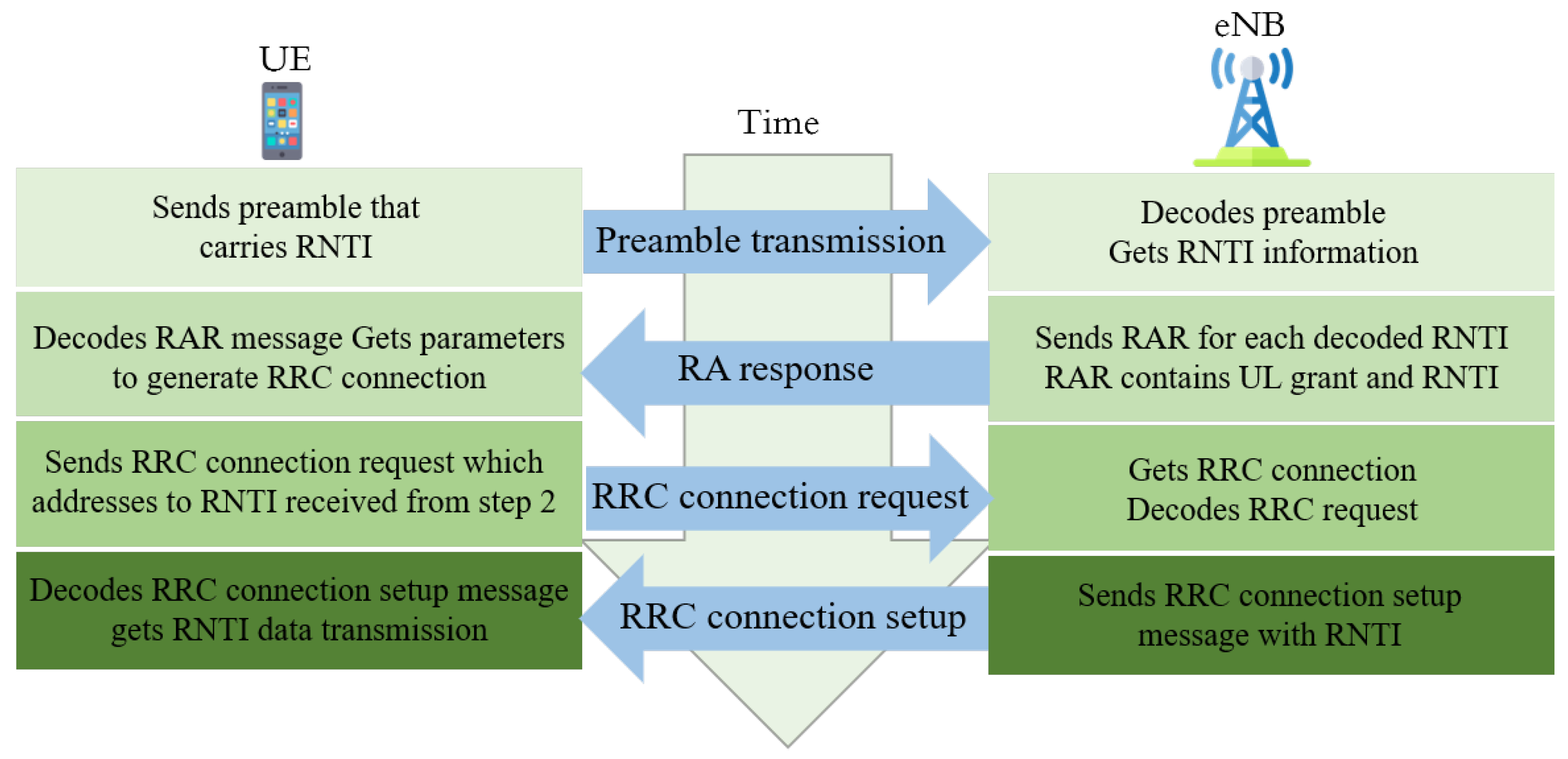

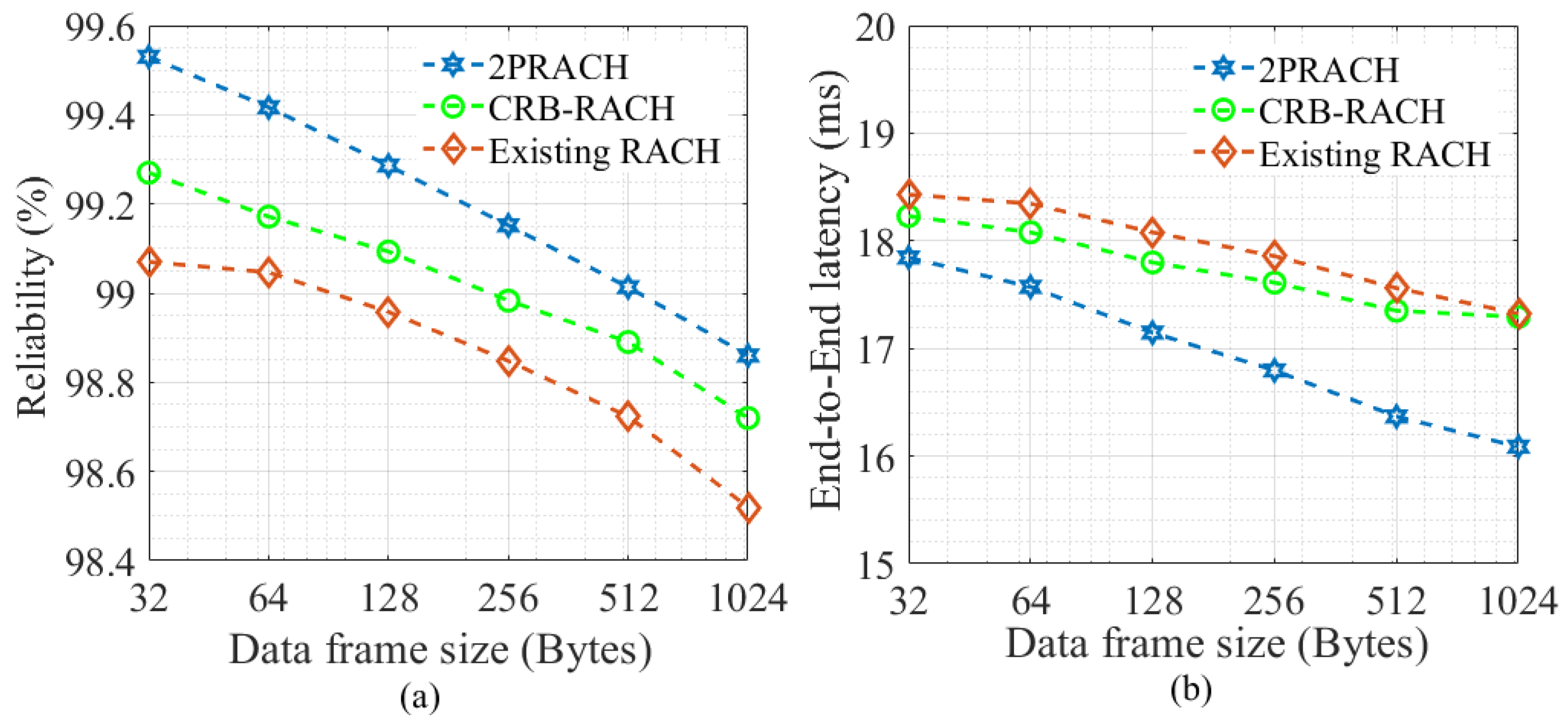
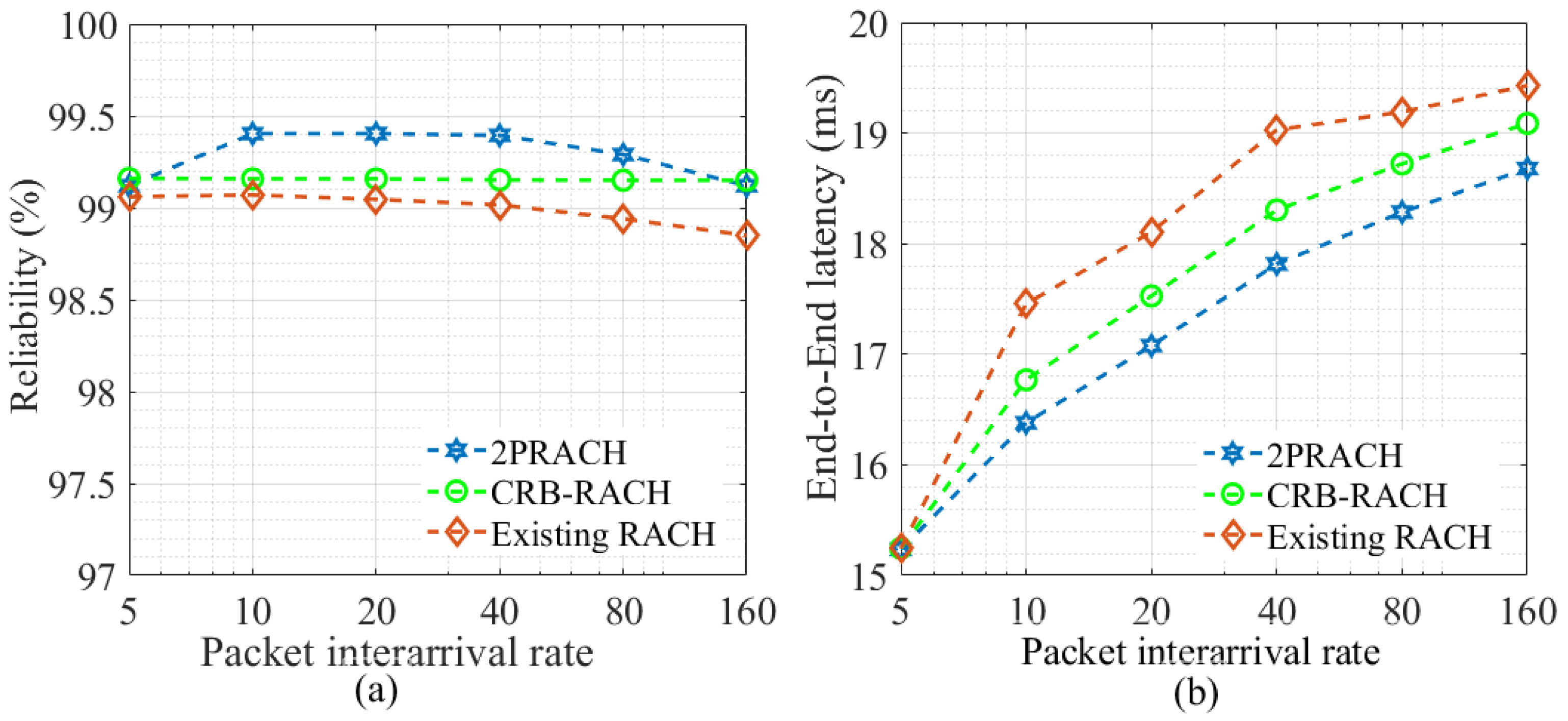
| Parameter | Value(s) |
|---|---|
| Simulation time | 100 s |
| Simulation model | LTE-EPC model |
| Number of eNBs | 2 |
| Number of UEs | |
| Distance between UE and eNB | 60 m |
| Data payload (packet) sizes | Bytes |
| Packet Interarrival rates | ms |
| Total number of RA preambles | 64 |
| CB-RA preambles | 52 |
| Rate parameter () | 8 |
Publisher’s Note: MDPI stays neutral with regard to jurisdictional claims in published maps and institutional affiliations. |
© 2021 by the authors. Licensee MDPI, Basel, Switzerland. This article is an open access article distributed under the terms and conditions of the Creative Commons Attribution (CC BY) license (http://creativecommons.org/licenses/by/4.0/).
Share and Cite
Almagrabi, A.O.; Ali, R.; Alghazzawi, D.; AlBarakati, A.; Khurshaid, T. A Poisson Process-Based Random Access Channel for 5G and Beyond Networks. Mathematics 2021, 9, 508. https://doi.org/10.3390/math9050508
Almagrabi AO, Ali R, Alghazzawi D, AlBarakati A, Khurshaid T. A Poisson Process-Based Random Access Channel for 5G and Beyond Networks. Mathematics. 2021; 9(5):508. https://doi.org/10.3390/math9050508
Chicago/Turabian StyleAlmagrabi, Alaa Omran, Rashid Ali, Daniyal Alghazzawi, Abdullah AlBarakati, and Tahir Khurshaid. 2021. "A Poisson Process-Based Random Access Channel for 5G and Beyond Networks" Mathematics 9, no. 5: 508. https://doi.org/10.3390/math9050508
APA StyleAlmagrabi, A. O., Ali, R., Alghazzawi, D., AlBarakati, A., & Khurshaid, T. (2021). A Poisson Process-Based Random Access Channel for 5G and Beyond Networks. Mathematics, 9(5), 508. https://doi.org/10.3390/math9050508








